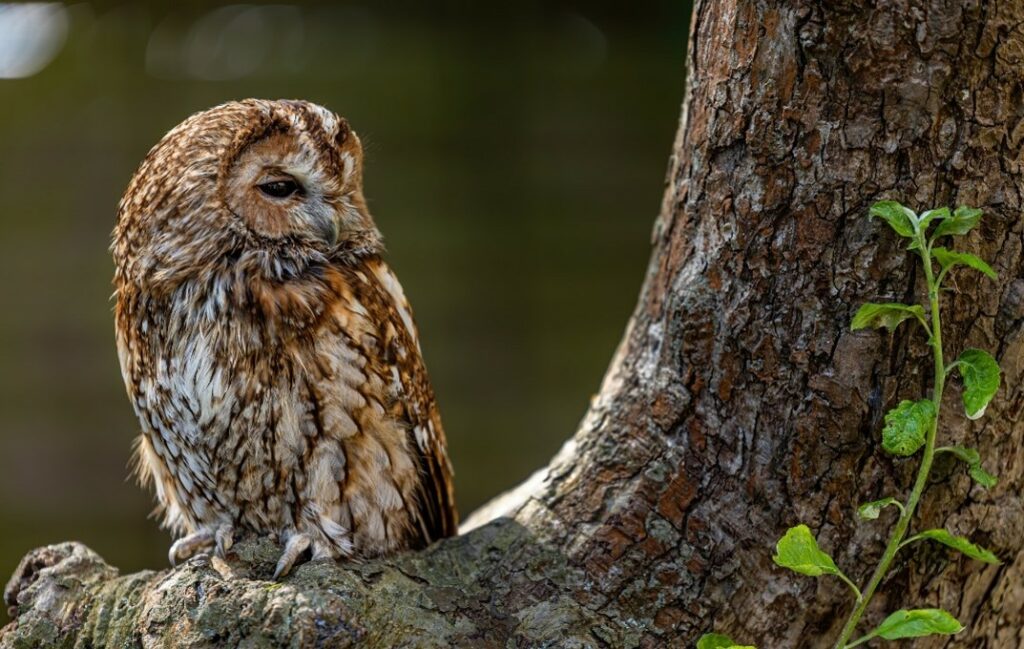By GWCT Farmland Ecology Placement student, Seshi Humphrey-Ackumey
The Owl Box Initiative focuses predominantly on the conservation of the barn owl (Tyto alba), and as an inspirational flagship species, aims to inspire people to engage in more wildlife-friendly farming. However, the UK supports five species of owl and last week, as I heard the distinctive ‘hooo, hu, huhuhuhooo’ of a male tawny owl (Stix aluco) on the site of the GWCT’s headquarters, I wanted to learn more.
At this time of year, the frequency of a male’s territorial calls will be starting to increase as the pair strengthen the defence of their 12-20ha (30-50 acres) territory for nesting. Prime tawny owl territory is broadleaf woodland or mature conifer plantations with tree cavities for roosting and high small mammal abundance. In the absence of tree cavities, they can use old crow nests, squirrel dreys, or owl boxes provided across the landscape. They can also be found in parks and large gardens.

Tawny owls are exceptional hunters, their directional hearing can locate small mammals scurrying across the woodland floor. Tawny owls mainly predate small mammals such as voles and mice but their diet is more varied in comparison to the barn owl; they are known to hunt rabbits, small birds such as starlings, bats, amphibians, large insects, and even fish in garden ponds, as well as some larger birds.
The nocturnal lifestyle of tawny owls makes it difficult to see them, despite them being the most common owl species in the UK. There are approximately 50,000 pairs across the British Isles but the species is entirely absent from the island or Ireland. In the day they are much less active, and their mottled chestnut brown or very occasionally grey feathers, blend them in with their wooded habitat, so you are much more likely to hear their nocturnal duet than to actually see them.
From autumn until late spring tawny owls will fiercely defend their territory to ensure they have familiar hunting grounds for themselves and their chicks. Tawny owls only lay one brood per year in early spring and can display very aggressive territorial behaviour which can often drive little owl and long-eared owls out of woodlands to reduce competition. They can even be aggressive to humans.
Each egg is incubated for 30 days as soon as it’s laid, unlike other bird groups. This means eggs will hatch asynchronously, so when there isn’t enough food, the older chick may eventually consume its younger siblings if there isn’t an abundance of prey in the area. As the chicks grow, they will start to explore nearby branches in a behaviour known as ‘branching’. After 5 weeks the chicks will fledge and leave the nest but stay in the general area for up to 3 months.
In 2015, tawny owls were put onto the Amber List of Birds of Conservation Concern due to a long-term decline since 1970 (Eaton et al. 2015). Estimations attribute any decline to a combination of factors, including changes in woodland management, increased urbanisation, habitat fragmentation, and the influence of climate change on small mammal numbers. More research is certainly needed, and recently the British Trust for Ornithology carried out a citizen science survey to shed more light on how to assess the UK’s Tawny owl population most effectively.
If you are looking to help in the conservation of the tawny owl, buying or making a nest box is a great way to encourage them to breed – take a look at my recent blog which provides guidance on making and siting a tawny owl nest box.
Support the Owl Box Initiative
You can help support the project by purchasing an Owl Box Initiative Supporter Badge or Living Nature Soft Toy Barn Owl from the GWCT.

I think we have a pair-in our garden you can hear them talking to each other from two evergreen oak trees, still not seen them (seen them flying at night) but I love there call